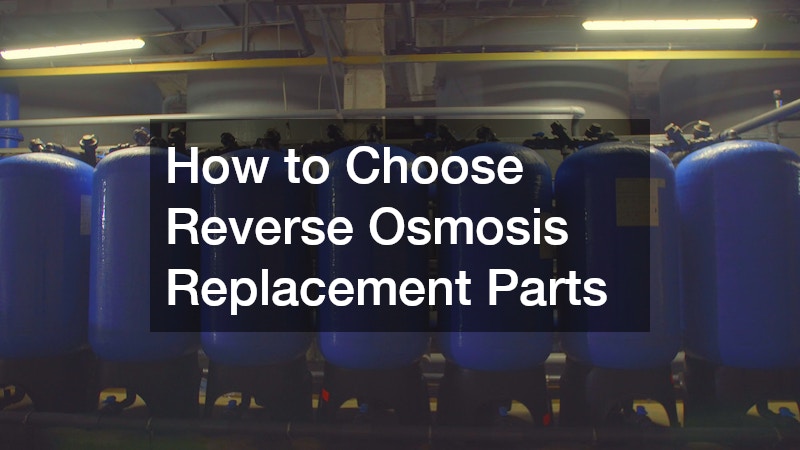Disclaimer: Concordia Research. This site provides general content for informational purposes only.
Reverse osmosis systems are essential for ensuring clean and safe drinking water. Selecting the right replacement parts is crucial to maintaining the efficiency and longevity of your system. This guide will walk you through the critical considerations in choosing replacement parts for your reverse osmosis system. Maintaining an optimal filtration setup not only preserves water quality but also ensures the system operates at peak efficiency and extends the unit’s overall lifespan.
What Are the Key Components of a Reverse Osmosis System?
Reverse osmosis systems are composed of several critical components that each serve distinct roles in purifying water. At the core of every system is the semipermeable membrane, designed to filter out contaminants at a molecular level.
Pre-filters, including sediment and carbon types, are vital in removing larger particles and chlorine, protecting the membrane from damage. Regular replacement of these pre-filters is essential to prevent buildup and maintain optimal membrane performance.
The system’s post-filters further enhance water quality by removing any remaining tastes or odors, ensuring the final output is clean and palatable. Flow restrictors help manage water pressure, maintaining a consistent flow that allows the system to function efficiently. Understanding these components can aid in diagnosing and resolving issues when they arise. Routine inspections can help detect early signs of wear or malfunction, preventing system-wide failures.
Knowing each component’s role helps identify which part might need replacement at any given time. A well-maintained reverse osmosis system significantly reduces potential problems, saving both time and cost related to extensive repairs or replacements. Selecting high-quality parts for replacement can ensure each component effectively contributes to the purification process. Investing in compatible, certified components also helps maintain the system’s performance and water quality standards.
How Frequently Should Reverse Osmosis Parts Be Replaced?
Regular maintenance and timely replacement of reverse osmosis parts are essential for optimal performance and water quality. Pre-filters typically require replacement every 6 to 12 months, depending on the water quality and usage levels. Membrane lifespan ranges from 2 to 5 years, contingent upon regular maintenance and local water conditions.
Post-filters often need renewal every 12 months to maintain the purity of the water after it exits the system. Establishing an accurate replacement timeline prolongs the system’s life and averts potential malfunctions caused by outdated components. Monitoring your water pressure and quality can provide early indicators for when parts might need attention sooner than scheduled.
Being vigilant about maintenance schedules can preempt water taste or odor changes, which often indicate failing parts. High sediment or chlorine levels in your water supply can accelerate wear, necessitating more frequent part replacements. It’s essential to adjust replacement intervals accordingly to match the demands of your specific water supply and consumption habits.
Where Can You Buy Quality Reverse Osmosis Replacement Parts?
Purchasing from reputable suppliers guarantees access to high-quality parts, critical for maintaining system performance and water purity. Researching and identifying suppliers with positive customer reviews and robust warranty offerings can safeguard against inferior products. Verifying certifications such as NSF/ANSI standards and ensuring parts meet health and safety requirements are crucial.
Shopping from established brands typically assures quality and compatibility with various system models. Suppliers often provide detailed product descriptions and technical support, aiding in selecting accurate replacements. Online platforms and local hardware stores both serve as viable sources, each with unique benefits tailored to consumer preferences.
While online shopping offers convenience and a wider selection, in-person purchases may facilitate direct consultation with knowledgeable staff. Securing parts from trusted suppliers reduces the risk of system deficiencies caused by substandard components. Building a relationship with reliable sellers can lead to better deals and advanced support for future needs.
How to Ensure Compatibility of Replacement Parts

Ensuring compatibility when selecting replacement parts is vital to avoid damage and maintain system efficacy. It’s critical to know your specific system model number to match components accurately. Consulting the system’s manual or the manufacturer’s website can provide guidelines and part numbers necessary for correct replacements.
Some components are universally adaptable, but securing parts specifically designed for your model is typically safer. Confirming compatibility not only preserves the integrity of your system but also ensures the continuation of effective water purification. Comprehensive research before purchasing can save both time and money from potential mismatches.
When purchasing parts, inquire about return policies in case a part is incompatible with your system. Compatibility ensures proper functioning and the warranty coverage related to your reverse osmosis system. Matching parts helps maintain operational efficiency and your system’s performance reliability.
Selecting the right reverse osmosis replacement parts is vital for the optimal performance of your water filtration system. By understanding the key components, setting a maintenance schedule, choosing reputable suppliers, and ensuring part compatibility, you can effectively maintain your system and ensure the highest quality water for your home. Regular checks and timely part replacements not only prolong system life but also secure health by consistently providing clean, safe drinking water.



